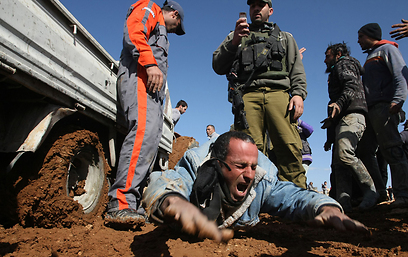Are journalistic ethics dead?
Op-ed: While claiming to uphold high standards, media giants post dubious anti-Israel photos
Tamar Sternthal
In recent days, two dramatic photographs alleged to be depicting Israeli army brutality have gone viral. One, which circulated on Facebook, purportedly showed an Israeli soldier stepping on a Palestinian girl and pointing an AK-47 at her head. It was exposed as Bahraini anti-Israel street theater.
After checking Palestinian, international and Israeli sources, it seems that the “injured worker,” Mahmoud Abu Qbeita, was, in fact, not actually injured. Moreover, there is no evidence that he was even run over. The Palestinian Center for Human Rights and the United Nations’ Office for the Coordination of Humanitarian Affairs, both of which provide comprehensive reports about all West Bank injuries, made no mention of the alleged injury.
 Herald Tribune changed original AFP caption
On the Israeli side, spokesman Capt. Barak Raz said soldiers were on site to protect Civilian Administration officials who were confiscating Palestinian construction equipment in an area not permitted for building. Abu Qbeita was on the ground blocking the trailer when he started screaming that he had been run over, although no one saw it happen. Initially, Abu Qbeita complained his left leg was injured. After an army medic’s examination found no wound, Abu Qbeita then claimed his right leg was injured. Raz said that the Palestinian Red Crescent likewise found nothing wrong with him.
Where are the x-rays?
Alarmed by what it termed “the ferocity of the attacks against the AFP,” the wire service issued a rare defense of its photo and caption. Remarkably, the Feb. 3 statement was at odds with the Jan. 25 caption on several basic facts. While the caption indicated that the vehicle ran “over his legs,” in plural, the AFP statement quoted Abu Qbeita: “it drove over one of my legs.” Likewise, while the caption said a soldier “drove a trailer hooked to a tractor over his legs,” AFP later quotes Abu Qbeita as saying the much larger tractor hit him.
If the x-rays confirm Abu Qbeita has fractures, why conceal them? If AFP cannot produce x-rays upholding Abu Qbeita’s claims, the Tribune, Washington Post, the Wall Street Journal and the other mainstream outlets have a responsibility to retract the photograph.
The writer directs the Israel office of the Committee for Accuracy in Middle East Reporting in America (CAMERA)
|
Wednesday, February 8, 2012
Are journalistic ethics dead?
Subscribe to:
Post Comments (Atom)
No comments:
Post a Comment